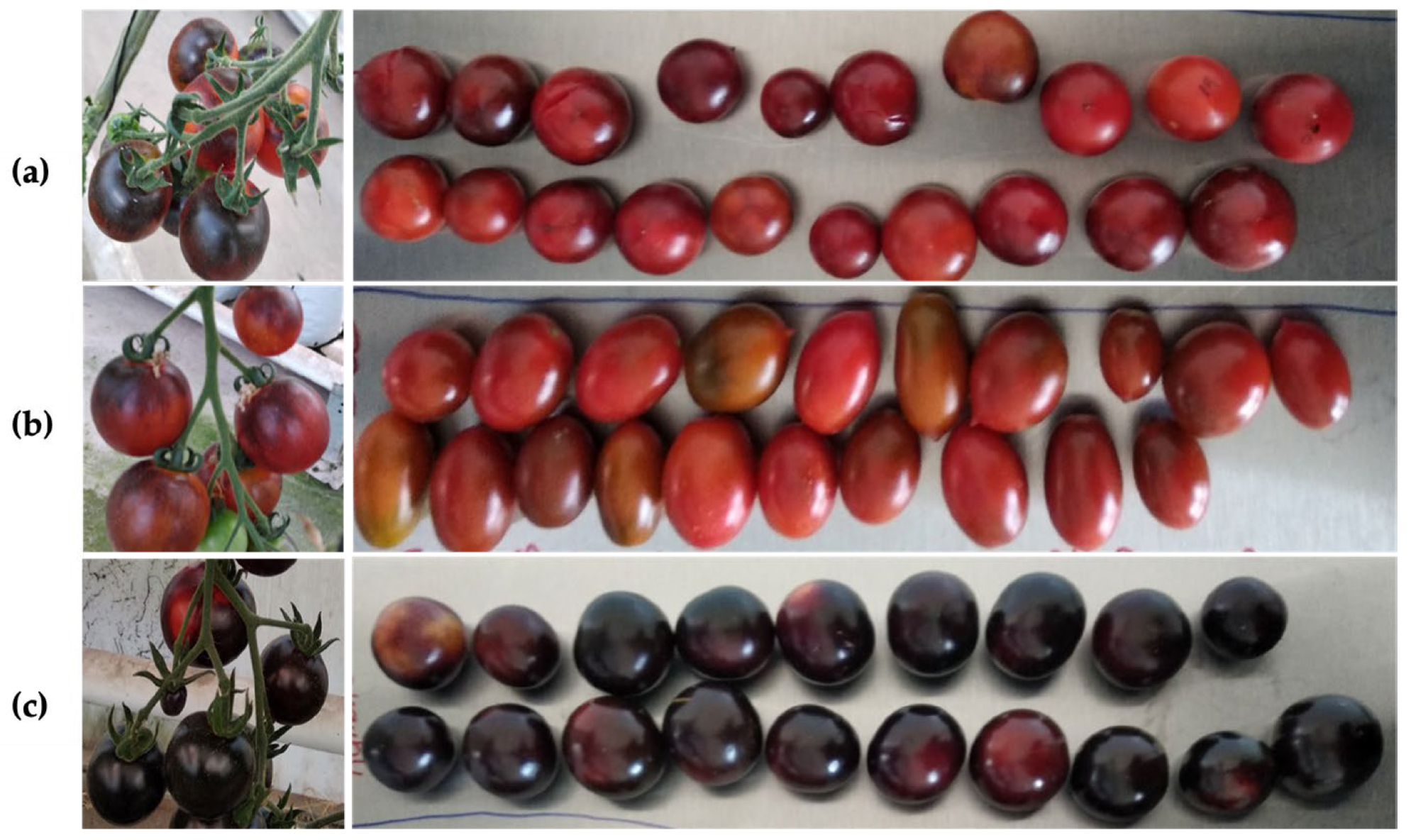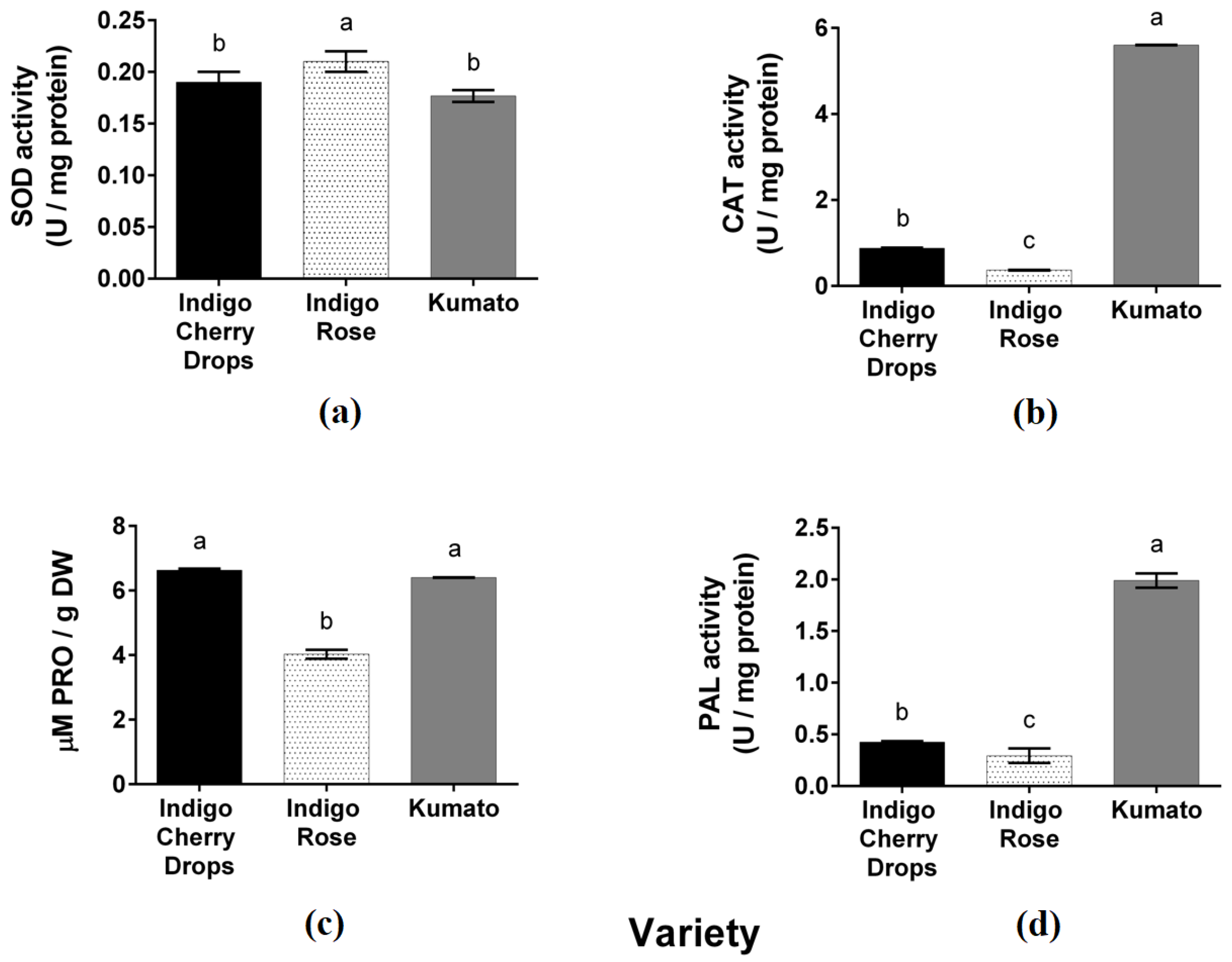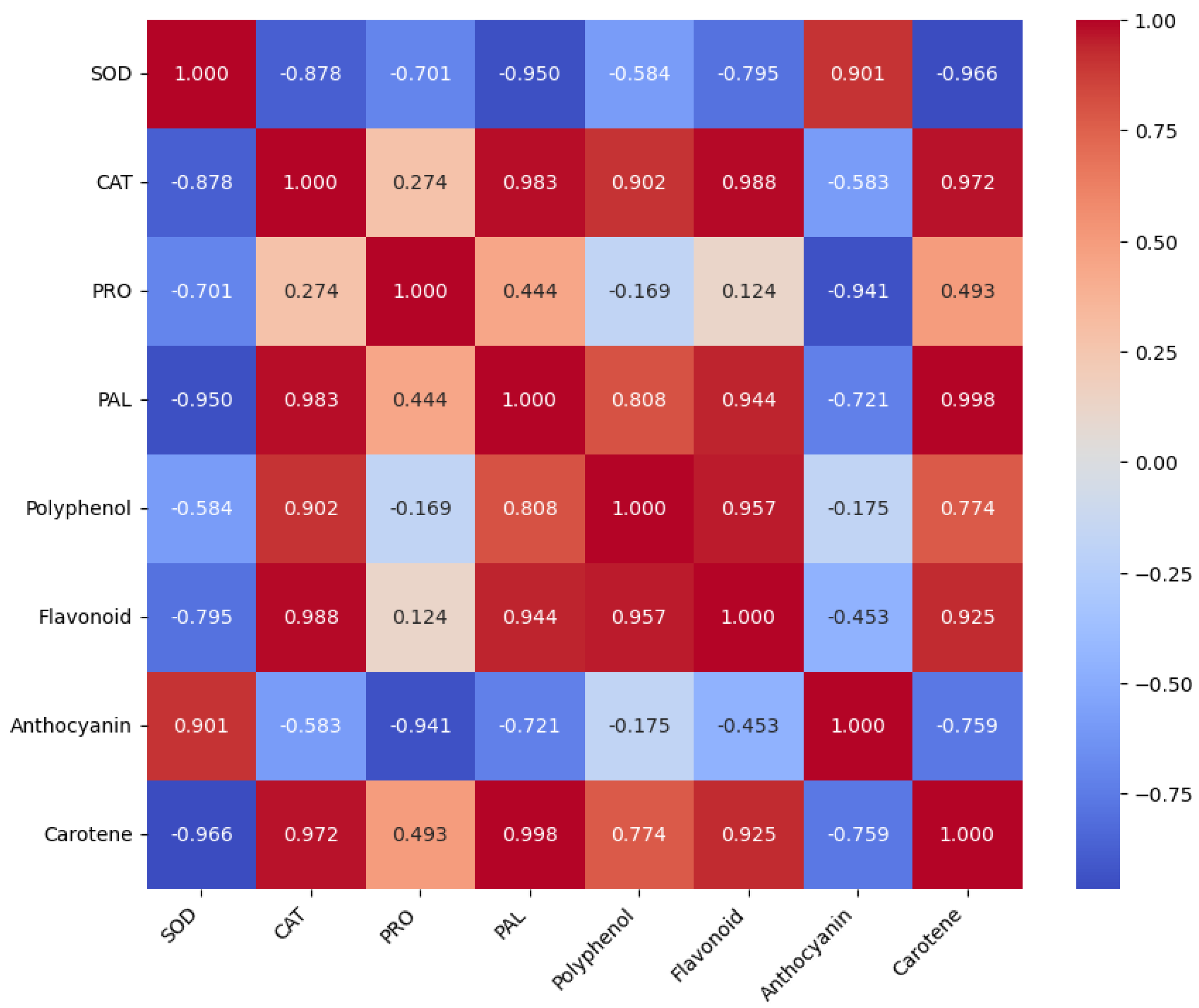Evaluation of Phenolic Compounds and Antioxidant Activity in Three Black Cherry Tomato Varieties Grown Under Greenhouse Conditions
Abstract
1. Introduction
2. Results
2.1. Biological Material
2.2. Enzymatic Activity
2.3. Phenolic Compounds
2.4. Interaction Between Endogenous Antioxidant Enzymes and Antioxidant Compounds
2.5. Antioxidant Activity
3. Discussion
4. Materials and Methods
4.1. Establishment of the Crop
4.2. Biological Material
4.3. Quality Control Procedures for the Determination of Enzymatic Activity, Phenolic Compounds, and Antioxidant Activity
4.3.1. Equipment Calibration
4.3.2. Use of Reference Materials and Standards
4.3.3. Sample Replication
4.3.4. Method Validation and Precision Control
4.4. Enzymatic Activity Determination
4.4.1. Sample Preparation for Enzymatic Assays
4.4.2. SOD Activity Assay
4.4.3. CAT Activity Assay
4.4.4. PAL Activity
4.4.5. PRO Activity
4.5. Determination of Phenolic Compounds
4.5.1. Extract Preparation
4.5.2. Total Polyphenols
4.5.3. Flavonoids
4.5.4. Total Anthocyanin Content
4.5.5. Carotenoids
4.6. Antioxidant Activity
4.6.1. DPPH Inhibition
4.6.2. ABTS Inhibition
4.7. Statistical Analysis
5. Conclusions
Author Contributions
Funding
Data Availability Statement
Conflicts of Interest
References
- Martemucci, G.; Costagliola, C.; Mariano, M.; D’andrea, L.; Napolitano, P.; D’Alessandro, A.G. Free Radical Properties, Source and Targets, Antioxidant Consumption and Health. Oxygen 2022, 2, 48–78. [Google Scholar] [CrossRef]
- Unsal, V.; Cicek, M.; Sabancilar, İ. Toxicity of Carbon Tetrachloride, Free Radicals and Role of Antioxidants. Rev. Environ. Health 2021, 36, 279–295. [Google Scholar] [CrossRef]
- Mittler, R. ROS Are Good. Trends Plant Sci. 2017, 22, 11–19. [Google Scholar] [CrossRef] [PubMed]
- Akomolafe, S.; Oboh, G. Characterization of Polyphenolic Constituents and Radical Scavenging Ability of Ripe Tomato and Red Pepper Fruits. J. Exp. Integr. Med. 2015, 5, 61. [Google Scholar] [CrossRef]
- Raza, B.; Hameed, A.; Saleem, M.Y. Fruit Nutritional Composition, Antioxidant and Biochemical Profiling of Diverse Tomato (Solanum lycopersicum L.) Genetic Resource. Front. Plant Sci. 2022, 13, 1035163. [Google Scholar] [CrossRef]
- Tovar-Pérez, E.G.; Aguilera-Aguirre, S.; López-García, U.; Valdez-Morales, M.; Ibarra-Zurita, A.K.; Ortiz-Basurto, R.I.; Chacón-López, A. Effect of Ultrasound Treatment on the Quality and Contents of Polyphenols, Lycopene and Rutin in Tomato Fruits. Czech J. Food Sci. 2020, 38, 20–27. [Google Scholar] [CrossRef]
- Palka, J.; Oscilowska, I.; Szoka, L. Collagen Metabolism as a Regulator of Proline Dehydrogenase/Proline Oxidase-Dependent Apoptosis/Autophagy. Amino Acids 2021, 53, 1917–1925. [Google Scholar] [CrossRef]
- Toscano, S.; Ferrante, A.; Leonardi, C.; Romano, D. PAL Activities in Asparagus Spears during Storage After Ammonium Sulfate Treatments. Postharvest Biol. Technol. 2018, 140, 34–41. [Google Scholar] [CrossRef]
- Scarano, A.; Gerardi, C.; Sommella, E.; Campiglia, P.; Chieppa, M.; Butelli, E.; Santino, A. Engineering the Polyphenolic Biosynthetic Pathway Stimulates Metabolic and Molecular Changes During Fruit Ripening in “Bronze” Tomato. Hortic. Res. 2022, 9, uhac097. [Google Scholar] [CrossRef]
- Joung, M.; Kim, Y.-J.; Shin, Y. Assessment of Lycopene, Polyphenols, Antioxidant Compounds, and Activities in Colored Cherry Tomato Cultivars Harvested in Korea. Food Sci. Biotechnol. 2024, 34, 1161–1170. [Google Scholar] [CrossRef]
- Di Lorenzo, C.; Colombo, F.; Biella, S.; Stockley, C.; Restani, P. Polyphenols and Human Health: The Role of Bioavailability. Nutrients 2021, 13, 273. [Google Scholar] [CrossRef] [PubMed]
- Pathare, P.B.; Al-Dairi, M. Effect of Simulated Vibration and Storage on Quality of Tomato. Horticulturae 2021, 7, 417. [Google Scholar] [CrossRef]
- Kruk, J.; Aboul-Enein, B.H.; Duchnik, E.; Marchlewicz, M. Antioxidative Properties of Phenolic Compounds and Their Effect on Oxidative Stress Induced by Severe Physical Exercise. J. Physiol. Sci. 2022, 72, 19. [Google Scholar] [CrossRef]
- Andrés, C.M.C.; Pérez de la Lastra, J.M.; Juan, C.A.; Plou, F.J.; Pérez-Lebeña, E. Polyphenols as Antioxidant/Pro-Oxidant Compounds and Donors of Reducing Species: Relationship with Human Antioxidant Metabolism. Processes 2023, 11, 2771. [Google Scholar] [CrossRef]
- Tena, N.; Martín, J.; Asuero, A.G. State of the Art of Anthocyanins: Antioxidant Activity, Sources, Bioavailability, and Therapeutic Effect in Human Health. Antioxidants 2020, 9, 451. [Google Scholar] [CrossRef]
- Bhandari, S.R.; Chae, Y.; Lee, J.G. Assessment of Phytochemicals, Quality Attributes, and Antioxidant Activities in Commercial Tomato Cultivars. Hortic. Sci. Technol. 2016, 34, 677–691. [Google Scholar] [CrossRef]
- Baek, M.W.; Lee, J.H.; Yeo, C.E.; Tae, S.H.; Chang, S.M.; Choi, H.R.; Park, D.S.; Tilahun, S.; Jeong, C.S. Antioxidant Profile, Amino Acids Composition, and Physicochemical Characteristics of Cherry Tomatoes Are Associated with Their Color. Antioxidants 2024, 13, 785. [Google Scholar] [CrossRef]
- FAOSTAT Data Indicators. Available online: http://faostat.fao.org/ (accessed on 5 April 2025).
- Servicio de Información Agroalimentaria y Pesquera, SIAP. Tomate Rojo (Jitomate). Av. Siembras y Cosech. 2020. Available online: https://www.gob.mx/siap (accessed on 5 April 2025).
- Asociación Mexicana de Horticultura Protegida, AMHPAC. Portal de Negocios y Mercados. Available online: https://negociosymercados.amhpac.org (accessed on 5 April 2025).
- Fideicomisos Instituidos en Relación con la Agricultura (FIRA). Panorama Agroalimentario 2019—Tomate Rojo; Fideicomisos Instituidos en Relación con la Agricultura: Ciudad de México, Mexico, 2019. [Google Scholar]
- Coyago-Cruz, E.; Corell, M.; Moriana, A.; Hernanz, D.; Stinco, C.M.; Mapelli-Brahm, P.; Meléndez-Martínez, A.J. Effect of Regulated Deficit Irrigation on Commercial Quality Parameters, Carotenoids, Phenolics and Sugars of the Black Cherry Tomato (Solanum lycopersicum L.) ‘Sunchocola’. J. Food Compos. Anal. 2022, 105, 104220. [Google Scholar] [CrossRef]
- Hernández-Vega, J.D.; Parola-Contreras, I.; Hernández Valencia, J.A.; Tovar-Pérez, E.G.; Guevara-González, R.G.; García-Trejo, J.F.; Guzmán-Cruz, R. Organoleptic and Quality Assessment in Three Black Cherry Tomato Varieties. Perspectivas de la Ciencia y la Tecnología; Universidad Autónoma de Querétaro: Santiago de Querétaro, Mexico, 2024; pp. 170–185. [Google Scholar]
- Mohammed, H.A.; Aljabary, A.M.A.O.; Halshoy, H.S.; Hama, J.R.; Rashid, H.A.; Rashid, H.W. Soil-Borne Microbes, Natural Stimulants, and Post-Harvest Treatments Alter Quality and Phytochemicals of Tomato Fruit. Int. J. Veg. Sci. 2023, 29, 544–556. [Google Scholar] [CrossRef]
- Parola-Contreras, I.; Tovar-Perez, E.G.; Rojas-Molina, A.; Luna-Vazquez, F.J.; Torres-Pacheco, I.; Ocampo-Velazquez, R.V.; Guevara-González, R.G. Changes in Affinin Contents in Heliopsis longipes (Chilcuague) after a Controlled Elicitation Strategy under Greenhouse Conditions. Ind. Crops Prod. 2020, 148, 112314. [Google Scholar] [CrossRef]
- Saed-Moucheshi, A.; Sohrabi, F.; Fasihfar, E.; Baniasadi, F.; Riasat, M.; Mozafari, A.A. Superoxide Dismutase (SOD) as a Selection Criterion for Triticale Grain Yield under Drought Stress: A Comprehensive Study on Genomics and Expression Profiling, Bioinformatics, Heritability, and Phenotypic Variability. BMC Plant Biol. 2021, 21, 148. [Google Scholar] [CrossRef] [PubMed]
- Castillo-Godina, R.G.; Foroughbakhch-Pournavab, R.; Benavides-Mendoza, A. Effect of Selenium on Elemental Concentration and Antioxidant Enzymatic Activity of Tomato Plants. J. Agric. Sci. Technol. 2016, 18, 233–244. [Google Scholar]
- Debnath, B.; Irshad, M.; Mitra, S.; Li, M.; Muhammad, H.; Li, M. Acid Rain Deposition Modulates Photosynthesis, Enzymatic and Non-Enzymatic Antioxidant Activities in Tomato. Int. J. Environ. Res. 2018, 12, 203–214. [Google Scholar] [CrossRef]
- Carvalho, M.E.A.; Piotto, F.A.; Franco, M.R.; Rossi, M.L.; Martinelli, A.P.; Cuypers, A.; Azevedo, R.A. Relationship Between Mg, B and Mn Status and Tomato Tolerance Against Cd Toxicity. J. Environ. Manag. 2019, 240, 84–92. [Google Scholar] [CrossRef] [PubMed]
- Pérez-Labrada, F.; López-Vargas, E.R.; Ortega-Ortiz, H.; Cadenas-Pliego, G.; Benavides-Mendoza, A.; Juárez-Maldonado, A. Responses of Tomato Plants under Saline Stress to Foliar Application of Copper Nanoparticles. Plants 2019, 8, 151. [Google Scholar] [CrossRef]
- López-Vargas, E.R.; Ortega-Ortíz, H.; Cadenas-Pliego, G.; De Alba Romenus, K.; de la Fuente, M.C.; Benavides-Mendoza, A.; Juárez-Maldonado, A. Foliar Application of Copper Nanoparticles Increases the Fruit Quality and the Content of Bioactive Compounds in Tomatoes. Appl. Sci. 2018, 8, 1020. [Google Scholar] [CrossRef]
- Ighodaro, O.M.; Akinloye, O.A. First Line Defence Antioxidants-Superoxide Dismutase (SOD), Catalase (CAT) and Glutathione Peroxidase (GPX): Their Fundamental Role in the Entire Antioxidant Defence Grid. Alexandria J. Med. 2018, 54, 287–293. [Google Scholar] [CrossRef]
- Marcon, T.R.; Rafagnin-da-Silva, A.; Meira, R.O.; Guedes, L.P.C.; Corsato, J.M.; Fortes, A.M.T. Viability of Using Organic Substrates According to Toxicity Tests and the Antioxidant Activities of Tomato Seeds and Seedlings. Int. J. Agric. Nat. Resour. 2020, 47, 1–11. [Google Scholar] [CrossRef]
- Kubala, S.; Wojtyla, L.; Quinet, M.; Lechowska, K.; Lutts, S.; Garnczarska, M. Enhanced Expression of the Proline Synthesis Gene P5CSA in Relation to Seed Osmopriming Improvement of Brassica Napus Germination under Salinity Stress. J. Plant Physiol. 2015, 183, 1–12. [Google Scholar] [CrossRef]
- Lin, F.; Xue, Y.; Huang, Z.; Jiang, M.; Lu, F.; Bie, X.; Miao, S.; Lu, Z. Bacillomycin D Inhibits Growth of Rhizopus Stolonifer and Induces Defense-Related Mechanism in Cherry Tomato. Appl. Microbiol. Biotechnol. 2019, 103, 7663–7674. [Google Scholar] [CrossRef]
- Wei, Y.; Zhou, D.; Peng, J.; Pan, L.; Tu, K. Hot Air Treatment Induces Disease Resistance Through Activating the Phenylpropanoid Metabolism in Cherry Tomato Fruit. J. Agric. Food Chem. 2017, 65, 8003–8010. [Google Scholar] [CrossRef] [PubMed]
- He, Y.; Zhu, Z.; Yang, J.; Ni, X.; Zhu, B. Grafting Increases the Salt Tolerance of Tomato by Improvement of Photosynthesis and Enhancement of Antioxidant Enzymes Activity. Environ. Exp. Bot. 2009, 66, 270–278. [Google Scholar] [CrossRef]
- Giosanu, D.; Vîjan, L.E. Appreciation of Quality for Some Tomatoes Varieties by Using the Determination of Physical-Chemical Parameters. Curr. Trends Nat. Sci. Curr. 2016, 5, 38–45. [Google Scholar]
- Mun, H.I.; Kwon, M.C.; Lee, N.R.; Son, S.Y.; Song, D.H.; Lee, C.H. Comparing Metabolites and Functional Properties of Various Tomatoes Using Mass Spectrometry-Based Metabolomics Approach. Front. Nutr. 2021, 8, 659646. [Google Scholar] [CrossRef]
- Blando, F.; Berland, H.; Maiorano, G.; Durante, M.; Mazzucato, A.; Picarella, M.E.; Nicoletti, I.; Gerardi, C.; Mita, G.; Andersen, Ø.M. Nutraceutical Characterization of Anthocyanin-Rich Fruits Produced by “Sun Black” Tomato Line. Front. Nutr. 2019, 6, 133. [Google Scholar] [CrossRef]
- Oluk, A.C.; Ata, A.; Ünlü, M.; Yazici, E.; Karaşahin, Z.; Eroğlu, E.Ç.; Canan, I. Biochemical Characterisation and Sensory Evaluation of Differently Coloured and Shaped Tomato Cultivars. Not. Bot. Horti Agrobot. Cluj-Napoca 2019, 47, 599–607. [Google Scholar] [CrossRef]
- Dzakovich, M.P.; Ferruzzi, M.G.; Mitchell, C.A. Manipulating Sensory and Phytochemical Profiles of Greenhouse Tomatoes Using Environmentally Relevant Doses of Ultraviolet Radiation. J. Agric. Food Chem. 2016, 64, 6801–6808. [Google Scholar] [CrossRef]
- Duma, M.; Alsina, I.; Dubova, L.; Erdberga, I. Quality of Tomatoes during Storage. Foodbalt 2017, 130–133. [Google Scholar] [CrossRef]
- da Silva Souza, M.A.; Peres, L.E.P.; Freschi, J.R.; Purgatto, E.; Lajolo, F.M.; Hassimotto, N.M.A. Changes in Flavonoid and Carotenoid Profiles Alter Volatile Organic Compounds in Purple and Orange Cherry Tomatoes Obtained by Allele Introgression. J. Sci. Food Agric. 2020, 100, 1662–1670. [Google Scholar] [CrossRef]
- Ooe, E.; Ogawa, K.; Horiuchi, T.; Tada, H.; Murase, H.; Tsuruma, K.; Shimazawa, M.; Hara, H. Analysis and Characterization of Anthocyanins and Carotenoids in Japanese Blue Tomato. Biosci. Biotechnol. Biochem. 2016, 8451, 341–349. [Google Scholar] [CrossRef][Green Version]
- Wang, H.; Sun, S.; Zhou, Z.; Qiu, Z.; Cui, X. Rapid Analysis of Anthocyanin and Its Structural Modifications in Fresh Tomato Fruit. Food Chem. 2020, 333, 127439. [Google Scholar] [CrossRef] [PubMed]
- Martí, R.; Roselló, S.; Cebolla-cornejo, J. Tomato as a Source of Carotenoids and Polyphenols Targeted to Cancer Prevention. Cancers 2016, 8, 58. [Google Scholar] [CrossRef] [PubMed]
- Halliwell, B.; Gutteridge, J.M.C. Free Radicals in Biology and Medicine; Oxford University Press: Oxford, UK, 2015; ISBN 0198717482. [Google Scholar]
- Birben, E.; Sahiner, U.; Sackesen, C.; Erzurum, S.; Kalayci, O. Oxidative Stress and Antioxidant Defense. World Allergy Organ. J. 2012, 22, 9–19. [Google Scholar] [CrossRef]
- Park, Y.S.; Kim, S.J.; Chang, H.I. Isolation of Anthocyanin from Black Rice (Heugjinjubyeo) and Screening of Its Antioxidant Activities. J. Microb. Biotechnol. 2008, 36, 55–60. [Google Scholar]
- Pisoschi, A.M.; Pop, A. The Role of Antioxidants in the Chemistry of Oxidative Stress: A Review. Eur. J. Med. Chem. 2015, 97, 55–74. [Google Scholar] [CrossRef]
- Combrink, N.J.J. Nutrient Solution Management, 1st ed.; Stellenbosch University: Stellenbosch, South Africa, 2019; ISBN 9780797218260. [Google Scholar]
- Opic, A.C. Manual De Manejo Sustentable Del Cultivo De Jitomate En Invernadero; Palibrio: Bloomington, IN, USA, 2013; ISBN 1463356447. [Google Scholar]
- Bradford, M.M. A Rapid and Sensitive Method for the Quantitation Microgram Quantities of Protein Utilizing the Principle of Protein-Dye Binding. Anal. Biochem. 1976, 72, 248–254. [Google Scholar] [CrossRef]
- Hayat, S.; Ahmad, H.; Ali, M.; Ren, K.; Cheng, Z. Aqueous Garlic Extract Stimulates Growth and Antioxidant Enzymes Activity of Tomato (Solanum lycopersicum). Sci. Hortic. 2018, 240, 139–146. [Google Scholar] [CrossRef]
- Afiyanti, M.; Chen, H.J. Catalase Activity Is Modulated by Calcium and Calmodulin in Detached Mature Leaves of Sweet Potato. J. Plant Physiol. 2014, 171, 35–47. [Google Scholar] [CrossRef]
- Lee, M.R.; Kim, C.S.; Park, T.; Choi, Y.S.; Lee, K.H. Optimization of the Ninhydrin Reaction and Development of a Multiwell Plate-Based High-Throughput Proline Detection Assay. Anal. Biochem. 2018, 556, 57–62. [Google Scholar] [CrossRef]
- Libbey, L.M.; Walradt, J.P. Analysis of Total Phenols and Other Oxidation Substrates and Antioxidants by Means of Folin-Ciocalteu Reagent. Lipids 1968, 3, 561. [Google Scholar] [CrossRef]
- Heimler, D.; Vignolini, P.; Dini, M.G.; Vincieri, F.F.; Romani, A. Antiradical Activity and Polyphenol Composition of Local Brassicaceae Edible Varieties. Food Chem. 2006, 99, 464–469. [Google Scholar] [CrossRef]
- Barba, A.I.; Hurtado, M.; Sánchez, M.C.; Fernández Ruiz, V.; López Sáenz De Tejada, M. Application of a UV-Vis Detection-HPLC Method for a Rapid Determination of Lycopene and β-Carotene in Vegetables. Food Chem. 2006, 95, 328–336. [Google Scholar] [CrossRef]
- Teng, H.; Lee, W.Y.; Choi, Y.H. Optimization of Ultrasonic-Assisted Extraction of Polyphenols, Anthocyanins, and Antioxidants from Raspberry (Rubus coreanus Miq.) Using Response Surface Methodology. Food Anal. Methods 2014, 7, 1536–1545. [Google Scholar] [CrossRef]




| Black Cherry Tomato Variety | ABTS | DPPH | ||
|---|---|---|---|---|
| % Inhibition | TEAC (Trolox/kg DW) | % Inhibition | TEAC (Trolox/kg DW) | |
| Indigo Cherry Drops | 58.71 ± 0.32 b | 117.98 ± 1.68 b | 47.48 ± 3.75 b | 358.23 ± 31.67 b |
| Indigo Rose | 41.39 ± 0.50 c | 27.58 ± 2.62 c | 65.83 ± 6.83 c | 513.13 ± 57.60 c |
| Kumato | 74.73 ± 0.34 a | 201.59 ± 1.78 a | 87.06 ± 3.41 a | 692.23 ± 28.74 a |
| Compound | Seed–Seedling (kg) | Plant Growth (kg) | Fruit Growth (kg) |
|---|---|---|---|
| Phosphoric acid | 0.470 | 0.470 | - |
| Nitric acid | - | - | 0.604 |
| Calcium nitrate | 6.500 | 2.950 | 3.850 |
| Sulphuric acid | - | - | 0.732 |
| Potassium sulphate | 1.875 | 1.000 | - |
| Potassium nitrate | 2.500 | - | 2.900 |
| Magnesium nitrate | - | 0.650 | 0.800 |
| Magnesium sulphate | 3.125 | 0.800 | 1.300 |
| Copper sulphate | 0.050 | - | - |
| Potassium phosphate | - | 0.820 | - |
| Potassium mono phosphate | - | - | 1.100 |
| Potassium chloride | - | 0.100 | 1.200 |
| Iron | 0.125 | 0.076 | 0.075 |
| Manganese | 0.025 | 0.030 | 0.030 |
| Copper | - | 0.003 | 0.002 |
| Zinc | 0.025 | 0.011 | 0.010 |
| Boron | 0.025 | 0.010 | 0.010 |
| Molybdenum | - | 0.001 | 0.001 |
Disclaimer/Publisher’s Note: The statements, opinions and data contained in all publications are solely those of the individual author(s) and contributor(s) and not of MDPI and/or the editor(s). MDPI and/or the editor(s) disclaim responsibility for any injury to people or property resulting from any ideas, methods, instructions or products referred to in the content. |
© 2025 by the authors. Licensee MDPI, Basel, Switzerland. This article is an open access article distributed under the terms and conditions of the Creative Commons Attribution (CC BY) license (https://creativecommons.org/licenses/by/4.0/).
Share and Cite
Hernández-Vega, J.D.; Parola-Contreras, I.; Tovar-Pérez, E.G.; Guevara-González, R.G.; Aguirre-Becerra, H.; Feregrino-Pérez, A.A.; Contreras-Medina, L.M.; Guzmán-Cruz, R. Evaluation of Phenolic Compounds and Antioxidant Activity in Three Black Cherry Tomato Varieties Grown Under Greenhouse Conditions. Plants 2025, 14, 1173. https://doi.org/10.3390/plants14081173
Hernández-Vega JD, Parola-Contreras I, Tovar-Pérez EG, Guevara-González RG, Aguirre-Becerra H, Feregrino-Pérez AA, Contreras-Medina LM, Guzmán-Cruz R. Evaluation of Phenolic Compounds and Antioxidant Activity in Three Black Cherry Tomato Varieties Grown Under Greenhouse Conditions. Plants. 2025; 14(8):1173. https://doi.org/10.3390/plants14081173
Chicago/Turabian StyleHernández-Vega, Josué Daniel, Ixchel Parola-Contreras, Erik Gustavo Tovar-Pérez, Ramón Gerardo Guevara-González, Humberto Aguirre-Becerra, Ana Angélica Feregrino-Pérez, Luis Miguel Contreras-Medina, and Rosario Guzmán-Cruz. 2025. "Evaluation of Phenolic Compounds and Antioxidant Activity in Three Black Cherry Tomato Varieties Grown Under Greenhouse Conditions" Plants 14, no. 8: 1173. https://doi.org/10.3390/plants14081173
APA StyleHernández-Vega, J. D., Parola-Contreras, I., Tovar-Pérez, E. G., Guevara-González, R. G., Aguirre-Becerra, H., Feregrino-Pérez, A. A., Contreras-Medina, L. M., & Guzmán-Cruz, R. (2025). Evaluation of Phenolic Compounds and Antioxidant Activity in Three Black Cherry Tomato Varieties Grown Under Greenhouse Conditions. Plants, 14(8), 1173. https://doi.org/10.3390/plants14081173








